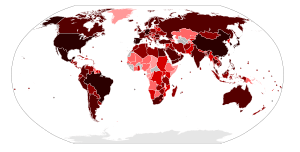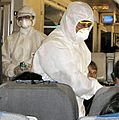2009 flu pandemic facts for kids

50 000+ confirmed cases 5,000+ confirmed cases 500+ confirmed cases 50+ confirmed cases 5+ confirmed cases 1+ confirmed cases
|
|
| Disease | Influenza |
|---|---|
| Virus strain | Pandemic H1N1/09 virus |
| Location | Worldwide except for Antarctica. |
| First case | Possible Central Mexico then the United States |
| Arrival date | January 2009 (Earliest case) |
| Origin | Veracruz, Mexico; North America. |
| Confirmed cases | According to the laboratory (widespread) |
| Suspected cases‡ | 700 million-1.4 billion cases |
| Recovered | Unknown due to the spread have been highly. |
|
Deaths
|
150,000–575,000 (Estaimated 284,000 deaths by the WHO) {Around 18,000 deaths due to the people that did not test} |
|
Territories
|
More than 200 countries. |
| ‡ Suspected cases have not been confirmed as being due to this strain by laboratory tests, although some other strains may have been ruled out. | |
The 2009 flu pandemic, also known as swine flu, was a worldwide outbreak of a new type of influenza (flu) virus. It started in early 2009 and lasted until late 2010. This was the second major flu pandemic caused by an H1N1 virus. The first was the Spanish flu pandemic from 1918 to 1920.
The virus was first identified in April 2009. It was a new kind of H1N1 flu that formed when different flu viruses mixed. These viruses came from birds, pigs, and humans. This mixing process is called reassortment.
Experts believe that about 11% to 21% of the world's population at the time got sick. This means between 700 million and 1.4 billion people might have caught the flu. Even though many people got sick, the number of deaths was much lower than with the Spanish flu. Around 150,000 to 575,000 people died from the 2009 flu pandemic. This means the chance of dying if you caught the flu was very low, about 0.01% to 0.08%.
Contents
What Was the 2009 Flu Pandemic?
The 2009 flu pandemic was a global outbreak of a new flu virus. It spread quickly across many countries. The virus was a new strain of H1N1. It was different from the regular seasonal flu viruses.
How the Virus Spread
The H1N1 virus spread from person to person, just like regular flu. It spread through tiny drops when someone coughed or sneezed. People could also get it by touching surfaces with the virus and then touching their face.
Symptoms of Swine Flu
The symptoms of the 2009 H1N1 flu were similar to regular flu. They included fever, cough, sore throat, and body aches. Some people also had vomiting or diarrhea. Most people had mild symptoms and recovered fully.
Global Response to the Pandemic
When the new H1N1 virus appeared, health organizations around the world took action. They wanted to understand the virus and stop its spread.
Developing a Vaccine
Scientists worked quickly to create a vaccine for the new H1N1 flu. Vaccines help your body learn to fight off a virus. Once the vaccine was ready, many countries started vaccination programs.
Public Health Measures
Governments and health groups also advised people on how to stay safe. They told people to wash their hands often and cover their mouths when they coughed. These simple steps helped slow down the spread of the virus.
Images for kids
-
President Barack Obama being vaccinated against H1N1 flu on 20 December 2009
-
Thermal imaging camera and screen, photographed in an airport terminal in Greece. Thermal imaging can detect elevated body temperature, one of the signs of swine flu.
See also
 In Spanish: Pandemia de gripe A (H1N1) de 2009-2010 para niños
In Spanish: Pandemia de gripe A (H1N1) de 2009-2010 para niños








